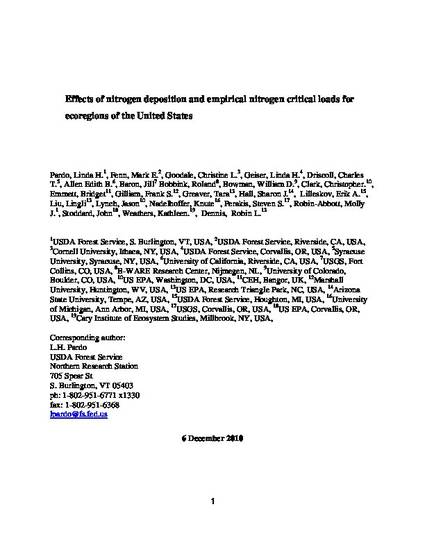
- air pollution,
- atmospheric N deposition,
- critical nitrogen loads,
- biodiversity,
- nitrate leaching,
- nitrogen saturation,
- plant nitrogen cycling,
- natural resource protection,
- vegetation type conversion
Human activity in the last century has led to a significant increase in nitrogen (N) emissions and atmospheric deposition. This N deposition has reached a level that has caused or is likely to cause alterations to the structure and function of many ecosystems across the United States. One approach for quantifying the deposition of pollution that would be harmful to ecosystems is the determination of critical loads. A critical load is defined as the input of a pollutant below which no detrimental ecological effects occur over the long-term according to present knowledge.
The objectives of this project were to synthesize current research relating atmospheric N deposition to effects on terrestrial and freshwater ecosystems in the United States, and to estimate associated empirical N critical loads. The receptors considered included freshwater diatoms, mycorrhizal fungi, lichens, bryophytes, herbaceous plants, shrubs, and trees. Ecosystem impacts included: (1) biogeochemical responses and (2) individual species, population, and community responses. Biogeochemical responses included increased N mineralization and nitrification (and N availability for plant and microbial uptake), increased gaseous N losses (ammonia volatilization, nitric and nitrous oxide from nitrification and denitrification), and increased N leaching. Individual species, population, and community responses included increased tissue N, physiological and nutrient imbalances, increased growth, altered root:shoot ratios, increased susceptibility to secondary stresses, altered fire regime, shifts in competitive interactions and community composition, changes in species richness and other measures of biodiversity, and increases in invasive species.
The range of critical loads for nutrient N reported for U.S. ecoregions, inland surface waters, and
freshwater wetlands is 1-39 kg N ha-1 y-1, spanning the range of N deposition observed over most
of the country. The empirical critical loads for N tend to increase in the following sequence for different life forms: diatoms, lichens and bryophytes, mycorrhizal fungi, herbaceous plants and shrubs, trees.
The critical load approach is an ecosystem assessment tool with great potential to simplify complex scientific information and communicate effectively with the policy community and the public. This synthesis represents the first comprehensive assessment of empirical critical loads of N for major ecoregions across the United States.
